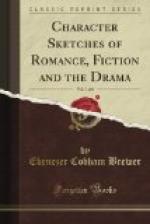Baldwin (Count), a fatal example of paternal self-will. He doted on his elder son Biron, but because he married against his inclination, disinherited him, and fixed all his love on Carlos his younger son. Biron fell at the siege of Candy, and was supposed to be dead. His wife Isabella mourned for him seven years, and being on the point of starvation, applied to the count for aid, but he drove her from his house as a dog. Villeroy (2 syl.) married her, but Biron returned the following day. Carlos, hearing of his brother’s return, employed ruffians to murder him, and then charged Villeroy with the crime; but one of the ruffians impeached, Carlos was arrested, and Isabella, going mad, killed herself. Thus was the wilfulness of Baldwin the source of infinite misery. It caused the death of his two sons, as well as of his daughter-in-law.—Thomas Southern, The Fatal Marriage (1692).
Baldwin, archbishop of Canterbury (1184-1190), introduced by sir W. Scott in his novel called The Betrothed (time, Henry II.).
BALDWINDE OYLEY, esquire of sir Brian de Bois Guilbert (Preceptor of the Knights Templars).—Sir W. Scott, Ivanhoe (time, Richard I.).
BALIN (Sir), or “Balin le Savage,” knight of the two swords. He was a Northumberland knight, and being taken captive, was imprisoned six months by king Arthur. It so happened that a damsel girded with a sword came to Camelot at the time of sir Balin’s release, and told the king that no man could draw it who was tainted with “shame, treachery, or guile.” King Arthur and all his knights failed in the attempt, but sir Balin drew it readily. The damsel begged him for the sword, but he refused to give it to any one. Whereupon the damsel said to him, “That sword shall be thy plague, for with it shall ye slay your best friend, and it shall also prove your own death.” Then the Lady of the Lake came to the king, and demanded the sword, but sir Balin cut off her head with it, and was banished from the court. After various adventures he came to a castle where the custom was for every guest to joust. He was accommodated with a shield, and rode forth to meet his antagonist. So fierce was the encounter that both the combatants were slain, but Balin lived just long enough to learn that his antagonist was his dearly beloved brother Balan, and both were buried in one tomb.—Sir T. Malory, History of Prince Arthur, i. 27-44 (1470).
“The Book of Sir Balin le Savage” is part i. ch. 27 to 44 (both inclusive) of sir T. Malory’s History of Prince Arthur.
BALINVERNO, one of the leaders in Agramant’s allied army.—Ariosto, Orlando Furioso (1516).
BALIOL (Edward), usurper of Scotland, introduced in Redgauntlet, a novel by sir W. Scott (time, George II.).
Baliol (Mrs.), friend of Mr. Croftangry, in the introductory chapter of The Fair Maid of Perth, a novel by sir W. Scott (time, Henry IV.).




